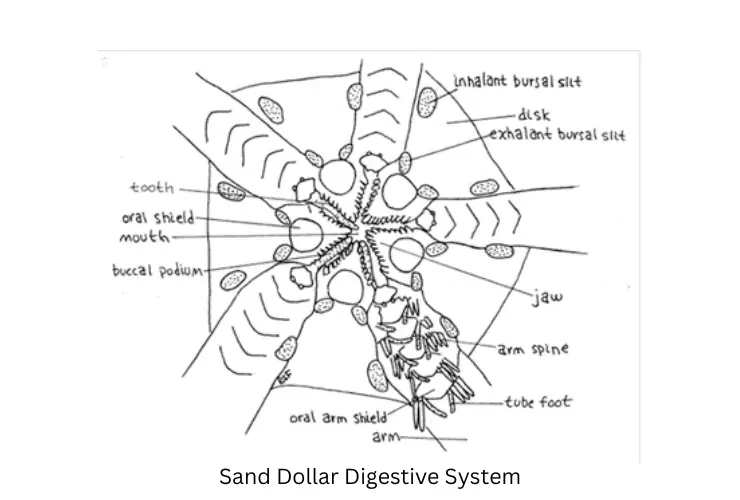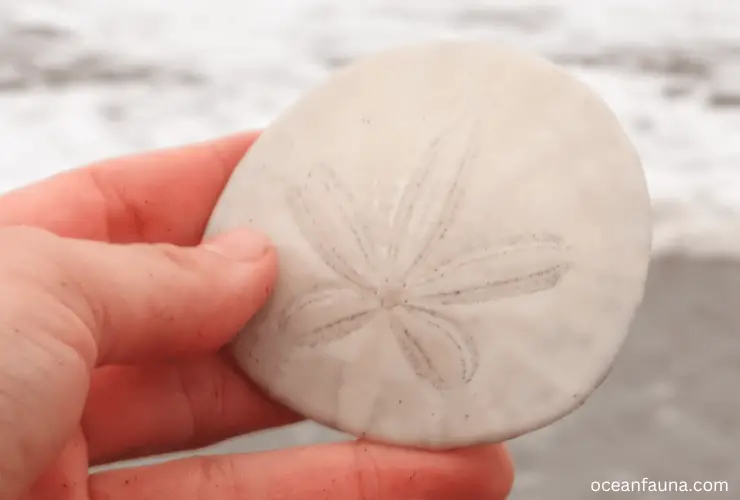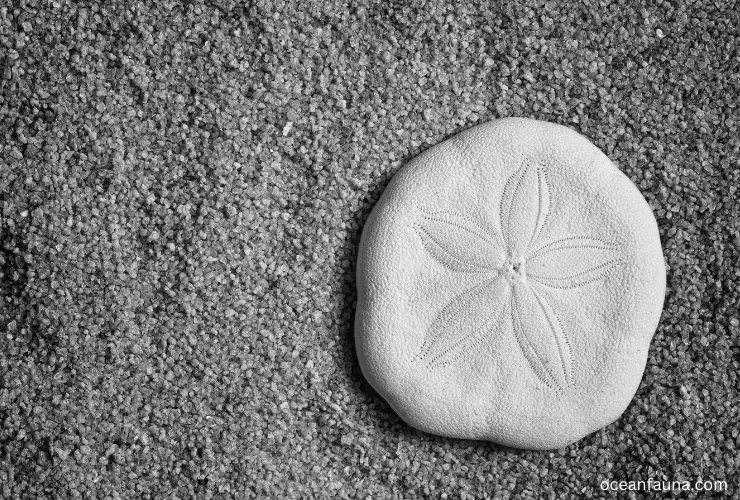Animals like octopuses, starfish, seagulls, snails, and sharks eat sand dollars. Due to the hard calcium carbonate shell, only a few organisms prey on sand dollars. On the other hand, sand dollars feed on various marine organisms. These include crustaceans, crabs, zooplankton, detritus, etc.
Sand dollars act as suspension and deposit feeders, depending on their position in the water. They usually take 15 minutes to chew food and nearly two days to digest them.
Want to learn more?
So, let’s tuck into the article and unravel the sweet truths!
Is a Sand Dollar Rare?
No!
Sand dollars are not rare species. They are prolific creatures, found in all the oceans and seas.
So, you can easily find one on any beach after the morning tide. They are primarily present in the tropical and temperate oceans of the Northern Hemisphere.
Are Sand Dollars Endangered?
No!
Fortunately, sand dollars are not endangered. They aren’t added to the list of the world wildlife fund WWF.
However, due to the over-collection and trawling, they are counted among the threatened species in some parts of the world.
That is why areas like Florida and California have made it illegal to collect a live sand dollar.
Does anything Eat Sand Dollars? What do they Eat?
Yes!
They are a few marine animals that eat sand dollars.
However, they have very few predators due to their hard exoskeleton.
Only those animals that can digest the hard exoskeleton or break it apart can prey upon sand dollars.
For example,
- Seagulls dash sand dollars on a hard surface to break the exoskeleton of sand dollars and eat the remaining parts.
- Starfish manage to eat hard sand dollars using their strong and sharp teeth.
- Snails prey upon baby sand dollars, mainly. However, they can’t eat adult sand dollars. In fact, a grown-up sand dollar eats snails.
- Octopuses are large marine creatures that can eat the whole sand dollar in one gulp.
A List of Sand Dollars Predators
Sand Dollars have an exoskeleton made of calcium carbonate. It is tough. That is why only a few animals can eat sand dollars.
Some of the common predators of sand dollars are
- Seagulls
- Snails
- Cods
- Sheepshead
- Flounder
- Haddock
- Shark
- Otter
- Octopus
- Starfish
- Crabs
However, humans cannot eat sand dollars due to the indigestible shell.
List of Foods Sand Dollars Love to Eat
Sand dollars being marine invertebrates, mostly prey upon aquatic plants.
Their diet includes eating:
- Crustaceans
- Zooplankton
- Snails
- Phytoplankton
- Diatoms
- Algae
- Bivalve
- Shrimp
- Sponges
- Small copepods
- Kelp
- Fish Larvae (occasionally)
They also scavenge on crabs and lobsters, but very seldom.
What Do the Larvae of Sand Dollars Eat?
Soon after the sperm fertilizes an egg, the baby’s sand dollars are termed larvae. These larvae are tiny in size.
However, like adult sand dollars, the larvae are omnivorous creatures that feed on marine plants and detritus.
The only problem is that the larvae of sand dollars are pretty tiny.
Therefore, they can engulf and eat only those microorganisms that are smaller than them.
They mainly eat microscopic algae and diatoms.
However, eating animals like snails isn’t an option for them due to their limited size.
How do Sand Dollars Capture Prey?
Sand Dollars have spines, cilia, pedicellariae, and tube feet on their exoskeleton.
These tiny creatures use these organs to ferry food particles and move them to the mouth present on the lower side of sand dollars.
Sand Dollars act as both suspension and deposit feeders, depending on their position in the water.
- They act as suspension feeders when held upright in the water.
- When lying flat on the ground in the seabed or ocean, they eat by sweeping food through their cilia to the mouth center. In this position, sand dollars act as deposit feeders.
How Do Sand Dollars Digest Food?
Sand Dollars have a complete digestive system that helps them digest properly. However, the process is relatively slow.

Once the food enters the body through the mouth, it reaches the long tube called the esophagus.
Here, the contraction of the upper and lower muscles of the esophagus pushes the food into the stomach cavity of the sand dollar.
In the stomach area, various digestive enzymes are present. These enzymes break down the particles and absorb the required nutrients.
After that, the remaining waste is passed into the intestine, making its way to the anus.
The anus is a separate opening present on the aboral side of sand dollars to excrete waste products.
How Long Does a Sand Dollar take to Eat and Digest?
Inside a sand dollar, there is a jaw with a set of five teeth. That helps sand dollars to grind and chew food.
A sand dollar typically takes 15 minutes to grind and chew a food particle properly.
However, it doesn’t get digested. Sand dollars take two days (48 hours) to digest the food properly.
Who Competes with Sand Dollars for Food?
Like sand dollars, other members of Phylum Echinodermata also reside in marine water, particularly in the low tidal region.
Due to similarities in adaptations, behavior, and life pattern, all the echinoderms compete with sand dollars for food. These include:
- Sea horses
- Sea Urchins
- Sea Cucumber
- Brittle Star
- Copepods
- Snails
- Scorpions
- Tadpoles
- Sea lilies
Apart from Echinoderms, the family members of Phylum Nematoda and Mollusca also eat algae, kelp, etc., and thus compete with sand dollars for food. A few of them are:
- Pinworm
- Hookworm
- Ascaris
- Whitworth
- Gastropods
- Bivalvia
- Cephalopods
However, many marine invertebrates and microorganisms are present in seas and oceans.
Therefore, the echinoderms don’t have to struggle much or opt for Charles Darwin’s “Survival of the fittest.”
They all have plenty of diatoms, crust, and other zooplankton to feed on.
Is it Possible to keep Sand Dollars as a Pet?
Yes!
You can keep sand dollars as a pet. However, make sure to provide these tiny creatures with a suitable environment, i.e.,
- Saline Water
- Required Food
Sand Dollars reside in marine water and not fresh water. Therefore, you need to keep sand dollars in slightly alkaline (saline) water.
Moreover, it is essential to provide them with lots of food to prey upon.

It is best to keep sand dollars in an aquarium with other marine invertebrates like crustaceans, crabs, etc.
However, ensure not to add any predator fish in the aquarium.
Frequently Asked Questions (FAQs)
Q.1 Do Sand Dollars have a mouth?
Yes!
Sand Dollars have a separate mouth opening. It is located on the lower side in the center of a petal-like pattern.
The spines and tube feet help to capture food and make their way to the mouth.
Q.2 How do sand dollars avoid predators when young?
Sand dollars adopt a unique way to avoid predators when young. They undergo cloning, a form of asexual reproduction.
This helps reduce the size of sand dollars and escape the predators’ eye.
Q.3 Why do sand dollars have only a few Predators?
Sand Dollars have only a few Predators. The reason is its hard exoskeleton test.
Only a few animals can digest the calcium carbonate shell. Therefore, only a fraction of animals can prey upon sand dollars.
Q.4 Are all Sand Dollars only Suspension feeders?
No!
Not all sand dollars are only suspension feeders. Some sea biscuits set up water currents using their inner vascular system and absorb food particles.
However, some act as deposit filters at times.
Conclusion
Sand Dollars eat tiny marine organisms as their prime source of food. These include crustaceans, zooplankton, phytoplankton, and other organic detritus.
These marine invertebrates use spines and tube feet to capture food.
On the other hand, marine animals like starfish, octopus, seagulls, and crabs prey upon sand dollars.
However, we can’t eat them due to their indigestible calcium carbonate test.


3 thoughts on “What Eats Sand Dollars? [Incuding Sand Dollar Diet List]”